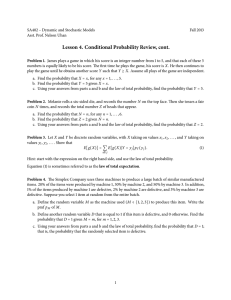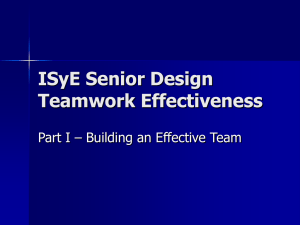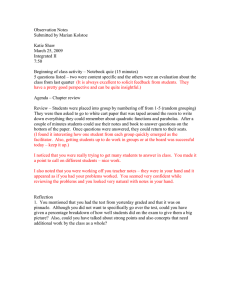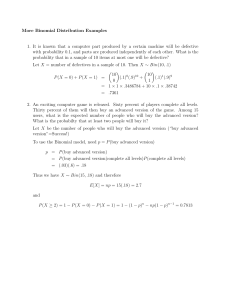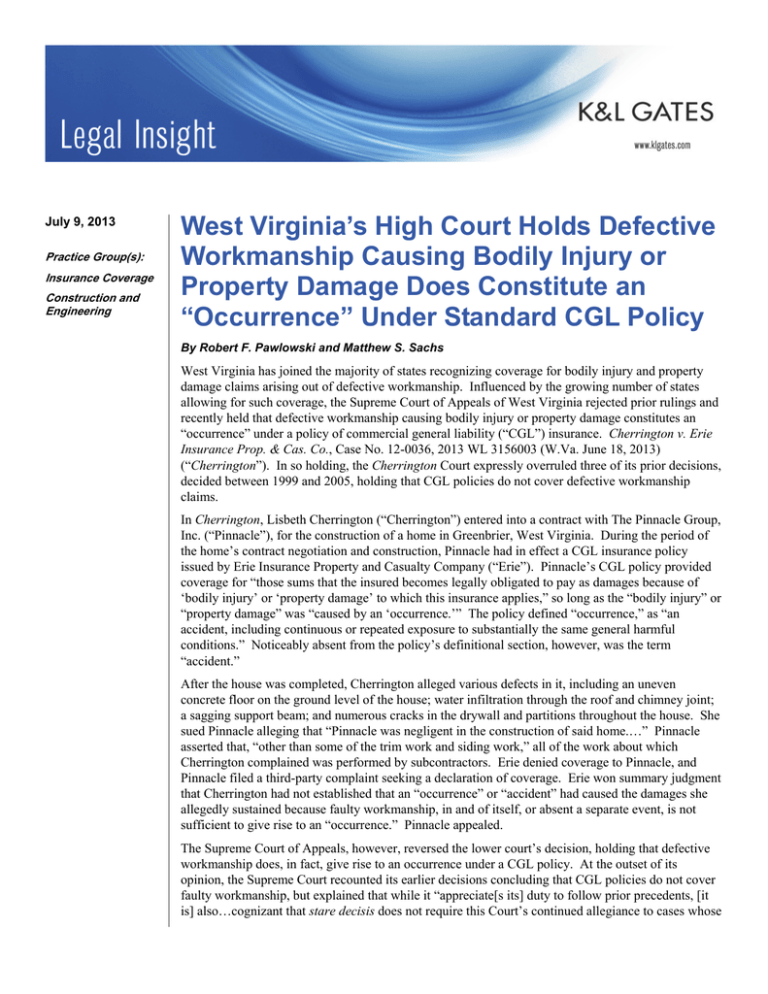
July 9, 2013
Practice Group(s):
Insurance Coverage
Construction and
Engineering
West Virginia’s High Court Holds Defective
Workmanship Causing Bodily Injury or
Property Damage Does Constitute an
“Occurrence” Under Standard CGL Policy
By Robert F. Pawlowski and Matthew S. Sachs
West Virginia has joined the majority of states recognizing coverage for bodily injury and property
damage claims arising out of defective workmanship. Influenced by the growing number of states
allowing for such coverage, the Supreme Court of Appeals of West Virginia rejected prior rulings and
recently held that defective workmanship causing bodily injury or property damage constitutes an
“occurrence” under a policy of commercial general liability (“CGL”) insurance. Cherrington v. Erie
Insurance Prop. & Cas. Co., Case No. 12-0036, 2013 WL 3156003 (W.Va. June 18, 2013)
(“Cherrington”). In so holding, the Cherrington Court expressly overruled three of its prior decisions,
decided between 1999 and 2005, holding that CGL policies do not cover defective workmanship
claims.
In Cherrington, Lisbeth Cherrington (“Cherrington”) entered into a contract with The Pinnacle Group,
Inc. (“Pinnacle”), for the construction of a home in Greenbrier, West Virginia. During the period of
the home’s contract negotiation and construction, Pinnacle had in effect a CGL insurance policy
issued by Erie Insurance Property and Casualty Company (“Erie”). Pinnacle’s CGL policy provided
coverage for “those sums that the insured becomes legally obligated to pay as damages because of
‘bodily injury’ or ‘property damage’ to which this insurance applies,” so long as the “bodily injury” or
“property damage” was “caused by an ‘occurrence.’” The policy defined “occurrence,” as “an
accident, including continuous or repeated exposure to substantially the same general harmful
conditions.” Noticeably absent from the policy’s definitional section, however, was the term
“accident.”
After the house was completed, Cherrington alleged various defects in it, including an uneven
concrete floor on the ground level of the house; water infiltration through the roof and chimney joint;
a sagging support beam; and numerous cracks in the drywall and partitions throughout the house. She
sued Pinnacle alleging that “Pinnacle was negligent in the construction of said home.…” Pinnacle
asserted that, “other than some of the trim work and siding work,” all of the work about which
Cherrington complained was performed by subcontractors. Erie denied coverage to Pinnacle, and
Pinnacle filed a third-party complaint seeking a declaration of coverage. Erie won summary judgment
that Cherrington had not established that an “occurrence” or “accident” had caused the damages she
allegedly sustained because faulty workmanship, in and of itself, or absent a separate event, is not
sufficient to give rise to an “occurrence.” Pinnacle appealed.
The Supreme Court of Appeals, however, reversed the lower court’s decision, holding that defective
workmanship does, in fact, give rise to an occurrence under a CGL policy. At the outset of its
opinion, the Supreme Court recounted its earlier decisions concluding that CGL policies do not cover
faulty workmanship, but explained that while it “appreciate[s its] duty to follow prior precedents, [it
is] also…cognizant that stare decisis does not require this Court’s continued allegiance to cases whose
West Virginia’s High Court Holds Defective Workmanship
Causing Bodily Injury or Property Damage Does Constitute
an “Occurrence” Under Standard CGL Policy
decisions were based upon reasoning which has become outdated or fallen into disfavor.” The Court
explicitly recognized “that a definite trend in the law has emerged since we rendered our [prior
decisions] sufficient to warrant this Court’s reconsideration of the issues decided therein….” This
“definite trend” is the majority view that defective workmanship may be an occurrence under a CGL
policy.
Ultimately, the Court relied upon two lines of reasoning to support its conclusion that defective
workmanship constitutes an “occurrence” under a CGL policy. First, the Court pointed to the fact that
Erie did not define the term “accident,” which is used in the policy’s definition of “occurrence.” The
Court found that pursuant to West Virginia law, circumstances giving rise to claimed damages or
injuries must not have been “deliberate, intentional, expected, desired, or foreseen” by the
policyholder to be accidental. Columbia Casualty Co. v. Westfield Insurance Co., 217 W. Va. 250,
617 S.E.2d 797 (2005). The Court determined the alleged damages were unintended, stating that “[i]t
goes without saying that the damages incurred by Ms. Cherrington during the construction and
completion of her home, or the actions giving rise thereto, were not within the contemplation of
Pinnacle when it hired the subcontractors alleged to have performed most of the work…. Nor can it be
said that Pinnacle deliberately intended or even desired the deleterious consequences that were
occasioned by its subcontractors’ substandard craftsmanship.” For these reasons, the Court did not
find that the alleged damages incurred by Ms. Cherrington were “deliberate, intentional, expected,
desired or foreseen” by Pinnacle.
Second, the Court held that excluding the defective workmanship from coverage in this case would be
incongruous with the policy’s express language providing coverage for the acts of subcontractors.
The Court explained that the CGL’s policy Exclusion L specifically excepts coverage for work
performed by subcontractors by the “your work” exclusion. According to the Court, “[a]pplication of
our prior holdings to find that the defective work of subcontractors does not constitute an
“occurrence” and thus is not covered by the subject CGL policy would, indeed, create an absurd result
when the policy expressly provides coverage for damages occasioned by subcontractors acting on
behalf of the insured.”
Finally, the Court noted that the defective workmanship must result in “bodily injury” or “property
damage” in order to satisfy the remainder of the policy’s insuring clause. The Court then focused its
analysis on whether Cherrington had sustained any “property damage,” which was defined in the
policy as either “[p]hysical injury to tangible property, including all resulting loss of use of that
property,” or “[l]oss of use of tangible property that is not physically injured.” According to the
Court, the extensive list of damaged items in Cherrington’s home resulting from the allegedly
defective construction satisfied either definition.
Cherrington, which liberates policyholders from fifteen years of adverse precedent, eliminates
uncertainty as to whether and when coverage exists under West Virginia law for property damage
caused by defective workmanship under standard-type CGL insurance policies. Although application
in any particular case may be fact-sensitive, and various exclusions contained in a CGL policy may
nonetheless bar coverage, West Virginia’s high court no longer sides with the minority of states
holding that defective workmanship is not an “occurrence” under CGL policies. Policyholders facing
construction-related claims under policies governed by West Virginia law should understand these
rules to assess how to maximize their insurance recovery.
2
West Virginia’s High Court Holds Defective Workmanship
Causing Bodily Injury or Property Damage Does Constitute
an “Occurrence” Under Standard CGL Policy
Authors:
Robert F. Pawlowski
robert.pawlowski@klgates.com
+1.973.848.4032
Matthew S. Sachs
matthew.sachs@klgates.com
+1.973.848.4121
Additional Contact:
Frederic J. Giordano
frederic.giordano@klgates.com
+1.973.848.4035
Anchorage Austin Beijing Berlin Boston Brisbane Brussels Charleston Charlotte Chicago Dallas Doha Dubai Fort Worth Frankfurt
Harrisburg Hong Kong Houston London Los Angeles Melbourne Miami Milan Moscow Newark New York Orange County Palo Alto Paris
Perth Pittsburgh Portland Raleigh Research Triangle Park San Diego San Francisco São Paulo Seattle Seoul Shanghai Singapore Spokane
Sydney Taipei Tokyo Warsaw Washington, D.C. Wilmington
K&L Gates practices out of 48 fully integrated offices located in the United States, Asia, Australia, Europe, the
Middle East and South America and represents leading global corporations, growth and middle-market companies,
capital markets participants and entrepreneurs in every major industry group as well as public sector entities,
educational institutions, philanthropic organizations and individuals. For more information about K&L Gates or its
locations, practices and registrations, visit www.klgates.com.
This publication is for informational purposes and does not contain or convey legal advice. The information herein should not be used or relied upon in
regard to any particular facts or circumstances without first consulting a lawyer.
©2013 K&L Gates LLP. All Rights Reserved.
3


